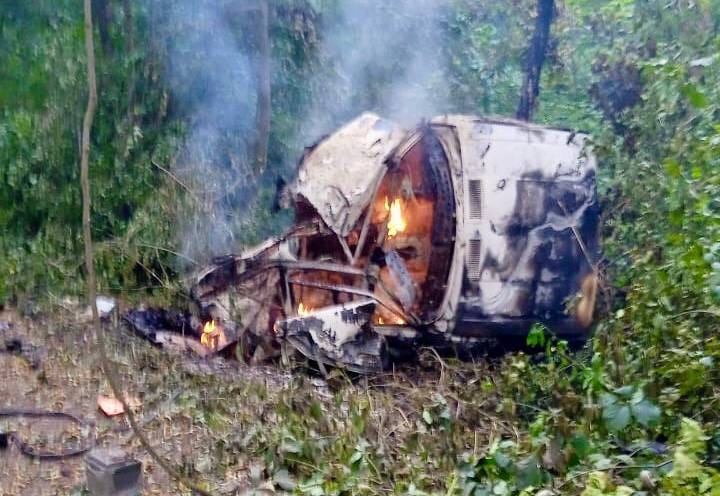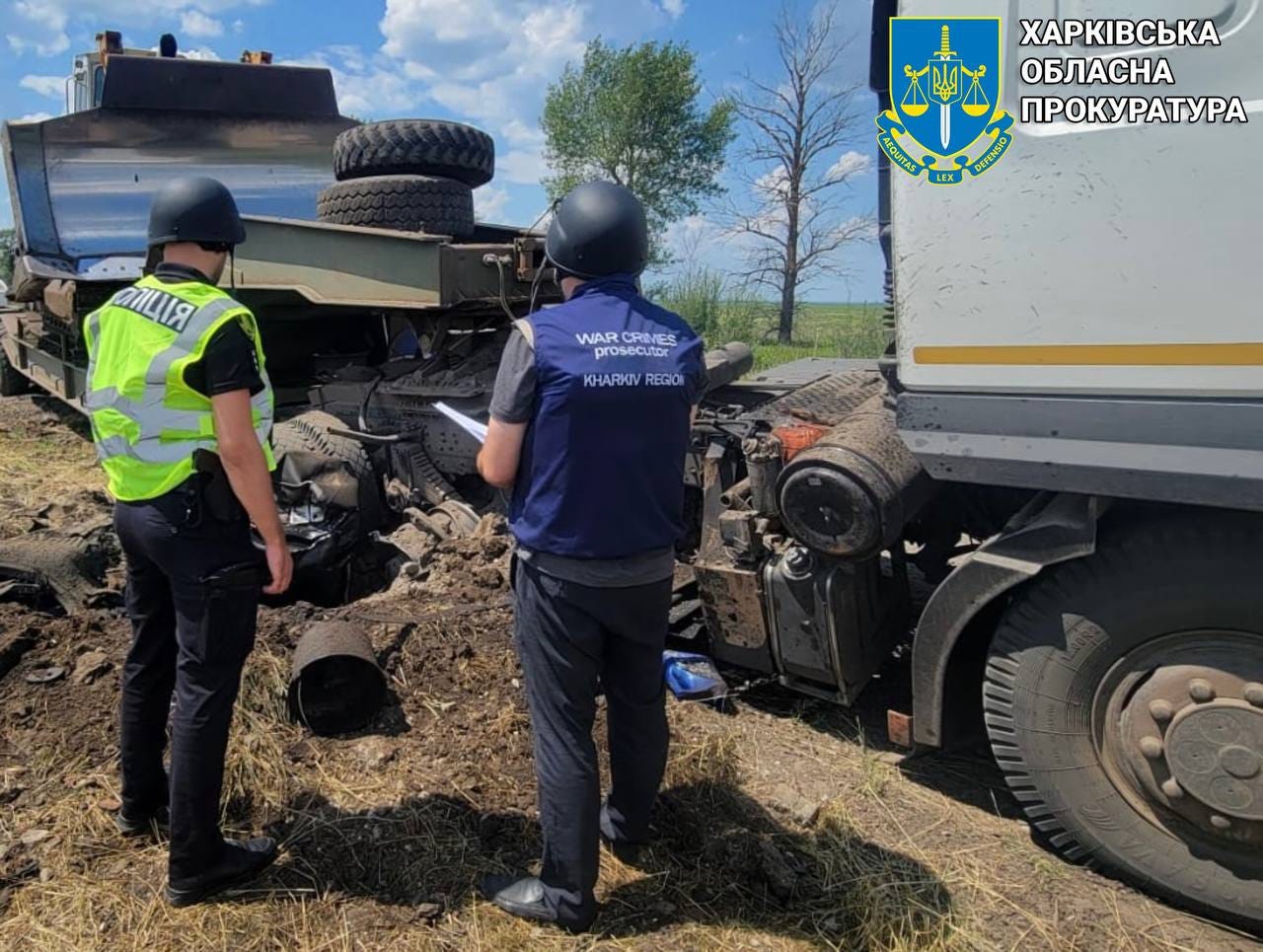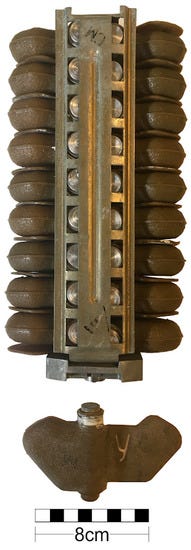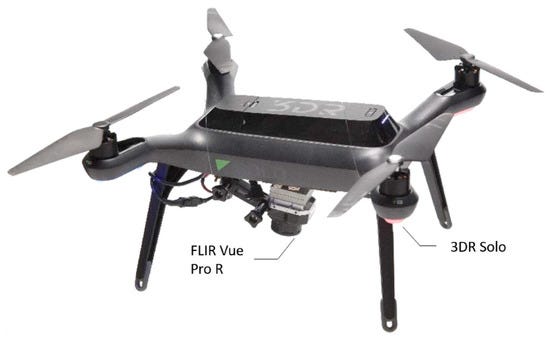Terror In Hiding: Land Mines Kill & Maim Ukrainians Throughout June & July
Land Mines Left Behind by Russian Occupiers in Kharkiv Oblast Give a Glimpse at a Difficult Future
Please, before reading further, consider donating to Nova Ukraine’s Humanitarian Demining Operations in the link below.
Image: Oleh Sinehubov
Today in Eastern France & Belgium, there are still places where farmers are still being maimed and killed by the “steel harvest” left behind from the combat of the First World War. Vietnam, Cambodia, and Laos all find themselves victims today from UXBs from the American carpet bombing during the Vietnam War. Ukraine finds itself among places like these as now the most-mine & munition polluted country in the world as of 2023 with 30% of its territory potentially containing unexploded ordnance (Vox).
Most recently in Ukraine, on July 7th, six members from multiple generations of a family were tragically killed by a Russian anti-tank mine near the village cemetery of Tsyrkuny, Derhachivskyi district, Kharkiv Oblast (pictured above). Governor of Kharkiv Oblast, Oleh Sinehubov, informed the public on Telegram: “as a result of detonation of an enemy mine, according to preliminary data of the law enforcement officers, four people were killed, among them - a child. The family was driving a car on a dirt road in the forest in the Kharkiv district. Identification of bodies continues. According to relatives of the deceased, there could have been six people in the car: 4 adults and 2 children. Further search for bodies and identification of persons is ongoing” (Oleh Sinehubov).
A chilling update on the developing situation was soon offered by the Kharkiv Regional Prosecutor’s Office on Telegram: “The bodies of three of the victims were preliminarily identified: a man, a woman aged about 40-50 and a boy aged 5-6. Fragments of the body of a baby were also found” (Kharkiv Regional Prosecutor's Office).
Sinehubov offered a final update regarding the status of all the victims. The status and presence of one victim was unknown for sometime. He identified the victims as a 53-year-old man, who was the driver; his 64-year-old sister; a man in his 40s, the driver's nephew; a 25-year-old woman, the driver's niece; her 5-year-old son; and a 2-month-old baby, the daughter of the 25-year-old woman (Oleh Sinehubov).
In response to the tragedy the authorities immediately opened investigations into the senseless crime. Kharkiv Regional Prosecutor’s Office stated, “Under the procedural control of the Derhachivskyi District Prosecutor's Office of Kharkiv Region, a pre-trial investigation was launched into the violation of the laws and customs of war combined with premeditated murder (Part 2 of Article 438 of the Criminal Code of Ukraine). (Kharkiv Regional Prosecutor’s Office).
Image: Kharkiv Regional Prosecutor’s Office
This incident is not isolated, as just a week prior, a tractor-trailer truck was severely damaged by a similar anti-tank munition in the neighboring Chuhuiv district in Kharkiv Oblast. Chuhuiv District Prosecutor’s Office stated that they were also undertaking pre-trail investigations into war crimes (Kharkiv Regional Prosecutor’s Office).
Anti-Tank Mines Claim Lives in Late June
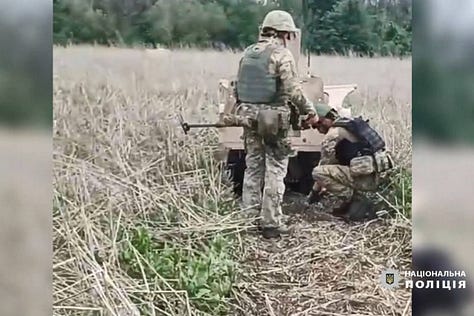
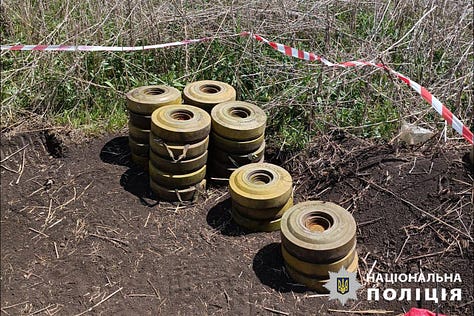
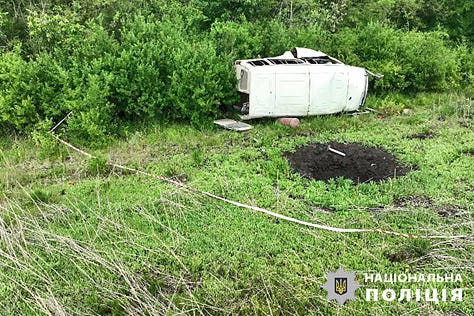
Images: The National Police of Ukraine
Late last month on June 21st & 24th in Kharkiv Oblast, three people were killed by anti-tank mines. On June 21st, the National Police of Ukraine received a missing persons tip from a woman in the Izium region of Kharkiv Oblast whose 34-year-old boyfriend had not returned as planned. The police discovered the remains of the missing man and his vehicle, but the prevalence of Russian TM-62M anti-tank mines (shown above in middle) made the recovery effort quite difficult. Mine fields take days to clear due to the harmful nature of the work. The National Police wrote on their website bulletin:
“Explosives specialists of the Kyiv police, who are currently working in a joint unit in the Kharkiv region, cleared the path to the car for three days to retrieve the body of the 34-year-old deceased driver. ‘The tragic incident happened on a field heavily mined by the enemy with anti-tank mines. In order to ‘break through’ the road to the van, we first used metal detectors and probes. In the future, in order to speed up the search for enemy ammunition, we connected an unmanned demining platform to work, with the help of which we covered a total of about 500 meters,’ says Ihor Voytsechivskyi, deputy head of the Department of Explosives Service of the National Security Service of Ukraine in Kyiv.”
Image: Oleh Sinehubov
Pertaining to the tragedy of the 24th, Sinehubov wrote, “Two people were killed as a result of an enemy mine detonation. In the morning, at 5:30 a.m., in the village of Slobozhanske, Lipetsk hromada, a car ran over a Russian anti-tank mine. There were two people in the cabin. The man died of his injuries on the spot, the woman died during evacuation to the hospital” (Oleh Sinehubov). The vehicle of the couple was completely obliterated by the anti-tank mine. Another undetonated and armed anti-tank mine can even be spotted in the right-hand foreground of image above.
The TM-62P3 anti-tank mine seen in the photo above carries 6.5kg of TNT in it (GICHD). Each of the TM-62M mines carries 7.5kg of TNT (GICHD). Often times, these anti-tank mines are employed by the Russians as roadblocks, leading to civilian vehicles becoming targets. It is a much cheaper, quicker, and less labor intensive solution than building concrete fortifications and staffing them with personnel. These roadblocks were left sporadically throughout Kharkiv Oblast as the Russians retreated during the Kharkiv Counteroffensive in Fall 2022. The mine roadblocks are often hard to spot while driving and there are no definitive maps left by the Russian Army as to where mines were placed. Therefore, two years later, these mines are killing and maiming Ukrainian civilians - and they likely will for the foreseeable future.
Walking on Eggshells: PFM-1 Anti-Personnel Mines
Image: Nikulin et al.
In addition to anti-tank mines, anti-personnel mines have proven to threaten the health and safety of Ukrainians throughout Ukraine’s previously occupied territories. The Soviet-manufactured PFM-1 “Petal” or “Butterfly” is incredibly effective in taking out infantry due to its ability to maim and immobilize infantry. The mines are very small and only have enough explosive charge to injure a human. They also have a very sensitive toxic liquid explosive compound inside which make them dangerous not only because of their ability to remove feet and toes, but also to poison those exposed to defunct leaking mines (GICHD).
The Geneva International Centre for Humanitarian Demining, in their munition guide for Ukraine, highlight the many methods of delivery of PFM-1’s: “This mine may be scattered from a KMGU dispenser attached to an aircraft, or by ground troops using a hand emplaced PKM projection cannister. It may also be delivered by means of 122mm Grad 9M22K or 220mm Uragan 9M27K3 rockets. The KSF-1 canister holds 8 racks of 9 PFM-1s each” (GICHD). The ability for these mines to be scattered across vast tracks of land creates a grim reality for Ukraine’s largely agricultural society. People’s farm land and forests have been coated in these small almost unnoticeable “butterfly” mines.
On July 2nd, in formerly occupied Kherson Oblast in Southern Ukraine, “A 58-year-old man was blown up by a Russian landmine in the village of Charivne, Beryslav district. As a result of the detonation, the victim received a mine-explosive injury, as well as a traumatic amputation of the foot. The man was hospitalized. Doctors assess his condition as moderate,” wrote the Kherson Regional Military Administration on Telegram.
And on July 1st, in Kharkiv’s Izium district, in the village of Yaremivka, “a 60-year-old woman, a resident of the village, was blown up from ‘petal’ mines” (Oleh Sinehubov). She survived, but with injuries. These incidents are just two of many hundreds of deaths and mutilations which have been registered since the beginning of the full-scale invasion in 2022 (Vox).
These incidents will continue to persist despite the typical government official tagline of “we remind you: all forest strips, roadsides of the de-occupied territories are extremely dangerous! Anti-tank, anti-personnel and other mines can be well camouflaged on the surface or in the ground.” Or the alternate: “If you see a mine - do not touch it, call 101 or 102” (Oleh Sinehubov). The path forward may reside in the employment of unmanned systems.
Walking on Eggshells: Picking Up the Pieces
Video: The National Police of Ukraine
In the June 21st demining operation, the National Police employed an unmanned demining system to aid in their ability to clear a path forward to the casualty and destroyed vehicle. The National Police said, “in order to speed up the search for enemy ammunition, we connected an unmanned demining platform to work, with the help of which we covered a total of about 500 meters… When the passage became safe, police officers together with the involved services retrieved the body of the deceased so that his relatives could bury him. In total, during the work in this area, specialists have already discovered about 100 TM-62 anti-tank mines” (The National Police of Ukraine).
Image: Nikulin et al.
In Nikulin et al.’s study of drones and their use in demining from Binghamton University in 2018, it was shown that the integration of increasingly cheaper thermal sensors will allow for ease of spotting PFM-1 anti-personnel mines in Ukraine (Nikulin et al.). These sensors are attached to DJI Mavic quadcopter drones, which are then flown over suspected minefields. By heat signature, the mines can then be identified and disposed of by sappers or by the drones themselves. Methods such as removal and off-site detonation are not really possible with PFM-1’s due to their sensitivity and oft-failing self-destruct mechanism. So, sympathetic detonation with other explosives may be employed. TM-62’s can be removed and diffused by hand, however, due to their much less sensitive fuses (GICHD).
Image: DOK-ING Ltd.
Unfortunately, in the meantime, Ukrainians will continue to die from landmines as long as Russia continues to occupy Ukrainian land. However, just last week, the new British Minister of Defense from the Labour Party, John Healy, announced 40 more demining vehicles to clear de-occupied territory as part of a new aid package (Ministry of Defense). Systems like the DOK-ING MV-10 that have been sent to Ukraine can help in clearing fields with chain flail attachments without injuring Ukraine’s valuable sappers and explosive experts (DOK-ING Ltd.). These effective unmanned systems offer fast and efficient removal solutions for sapper and demining operations around the globe. Western allies can continue to provide these essential cutting-edge systems to help prevent the deaths and further maiming of the Ukrainian people.
Video: DOK-ING Ltd.
Bibliography
DOK-ING Ltd. (2024, June 18). MV-10 - DOK-ING. DOK-ING. https://dok-ing.hr/defence-security/mv-10/
Evans, R., Seddon, B., Jovana Carapic, State Emergency Services of Ukraine, Danish EOD and Search Center, Dutch EOD Center, Swiss EOD Center, Moorhouse, S., & Montgomery, J. (2022). Explosive Ordnance guide for Ukraine. In Explosive Ordnance Guide for Ukraine (Second) [Book]. GICHD. https://www.gichd.org/fileadmin/uploads/gichd/Publications/GICHD_Ukraine_Guide_2022_Second_Edition_web.pdf
Kirby, J. (2023, November 30). There are now more land mines in Ukraine than almost anywhere else on the planet. Vox. https://www.vox.com/world-politics/2023/11/30/23979758/ukraine-war-russia-land-mines-artillery-humantarian-crisis
Kitsoft. (n.d.). Національна поліція України. https://www.npu.gov.ua/news/stolychni-vybukhotekhniky-uprodovzh-trokh-dniv-rozminovuvaly-shliakh-do-avto-iz-zahyblym-cholovikom-iakyi-na-kharkivshchyni-pidirvavsia-na-vorozhii-protytankovii-mini?v=667523597e1db
Ministry of Defence. (2024, July 7). New Defence Secretary pledges to step up support for Ukraine on visit to Odesa. GOV.UK. https://www.gov.uk/government/news/new-defence-secretary-pledges-to-step-up-support-for-ukraine-on-visit-to-odesa
Nikulin, A., De Smet, T., Baur, J., Frazer, W., & Abramowitz, J. (2018). Detection and Identification of Remnant PFM-1 ‘Butterfly Mines’ with a UAV-Based Thermal-Imaging Protocol. Remote Sensing, 10(11), 1672. https://doi.org/10.3390/rs10111672
Олег Синєгубов, голова Харківської ОДА. (n.d.). Telegram. https://t.me/synegubov/10072
Олег Синєгубов, голова Харківської ОДА. (n.d.). Telegram. https://t.me/synegubov/10182
Олег Синєгубов, голова Харківської ОДА. (n.d.). Telegram. https://t.me/synegubov/10291
Олег Синєгубов, голова Харківської ОДА. (n.d.). Telegram. https://t.me/synegubov/10294
Олег Синєгубов, голова Харківської ОДА. (n.d.). Telegram. https://t.me/synegubov/10295
Харківська обласна прокуратура. (n.d.). Telegram. https://t.me/prokuratura_kharkiv/17341
Харківська обласна прокуратура. (n.d.). Telegram. https://t.me/prokuratura_kharkiv/17445
🇺🇦Херcонська ОДА (ОВА). (n.d.). Telegram. https://t.me/khersonskaODA/21363



